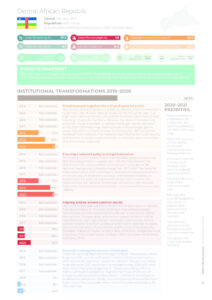Nutrition situation
Under five stunting (%)
37.5
Under five overweight (%)
1
Anaemia in women 15-49 years (%)
46
Under five wasting (%)
6.5
Low birth weight (%)
14.5
0 to 5-month-old exclusive breastfeeding (%)
28.8
Adolescent overweight (%)
Male: 6.1
/ Female: 14.1
Adult overweight (%)
Male: 18.3
/ Female: 33.2
Adult obesity (%)
Male: 3.7
/ Female: 10.9
Adult diabetes (%)
Male: 8
/ Female: 7.6
COVID-19 snapshot
Measures taken to mitigate risks during the COVID-19 pandemic led to the closure of school canteens and a rise in poverty levels among vulnerable populations, which had already seen an increase due to the military and political crisis.
Institutional transformations 2019-2020
Bringing people together into a shared space for action
The Central African Republic now has, by decree, a SUN Government Focal Point, the Minister Special Advisor to the Prime Minister. The high-level commitment has allowed the National Committee to hold meetings chaired by the Prime Minister, the Head of Government. It has also made it possible to validate and begin implementation of the 2020–2021 road map. Development of the strategic plan is under way and monthly meetings are being held, with occasional feedback from missions. The Parliamentary Alliance for Food Security and Nutrition is in place and the prefects and prefectural committee chairs have been inducted.Ensuring a coherent policy and legal framework
The Mutual Commitment Framework established by the technical and financial partners in agreement with the Government has enabled the first achievements of the projects included in the National Recovery and Peacebuilding Plan 2017–2021. The National Committee’s 2020–2021 road map is validated and places emphasis on the process of developing strategic and operational plans, to supplement the political, legal and economic frameworks. It is expected that the National Committee will become the National Council for Food Security and Nutrition, to increase effectiveness and visibility.Aligning actions around common results
The multi-stakeholder platform should define the Common Results Framework based on the 2020–2021 road map and encourage the networks and the parliamentary alliance to commit to taking joint actions. Consequently, actions that support nutrition will be capitalised on, with high-impact outcomes. Furthermore, several sectoral reports have been produced and make it possible to assess the nutritional status of populations and the level of food security (Multiple Indication Cluster Survey 6 data, 2019/2020; Integrated Food Insecurity Phase Classification analyses, 2020; European Food Safety Authority, 2020).Financial tracking and resource mobilisation
Financial tracking depends on budget analysis. This exercise, which began in 2018, was not sufficiently understood to be resumed in 2019. The results, therefore, cannot be adopted. This process needs to be started in 2021; moreover it is included in the 2020–2021 road map, which has been budgeted for. Capacity-building of Focal Points will make it possible to improve their involvement in the budgetary process (annual department conference and resource mobilisation operation). Finally, the technical and financial partners have committed to provide 49 per cent of the planned funding for the road map.2020-2021 Priorities
- Improve resource mobilisation to implement the actions outlined in the 2020–2021 road map.
- Build the capacity of focal points in network coordination (factfinding mission).
- Develop a national multisectoral strategic plan and a budgeted operational plan.
- Develop advocacy tools and a communication plan.
- Manage and monitor budgetary allocations to support and promote food security and nutrition.
- Convene the second national food security and nutrition meetings.
- Strengthen the multi-stakeholder platform.
Download

